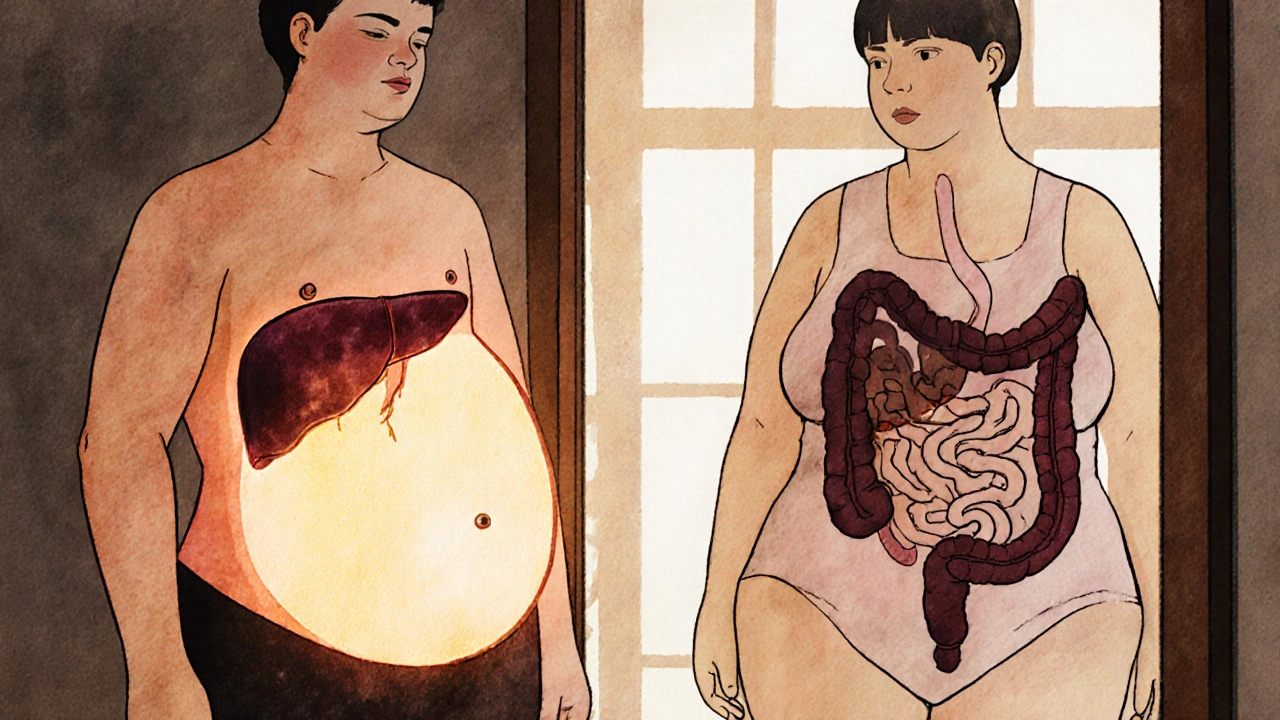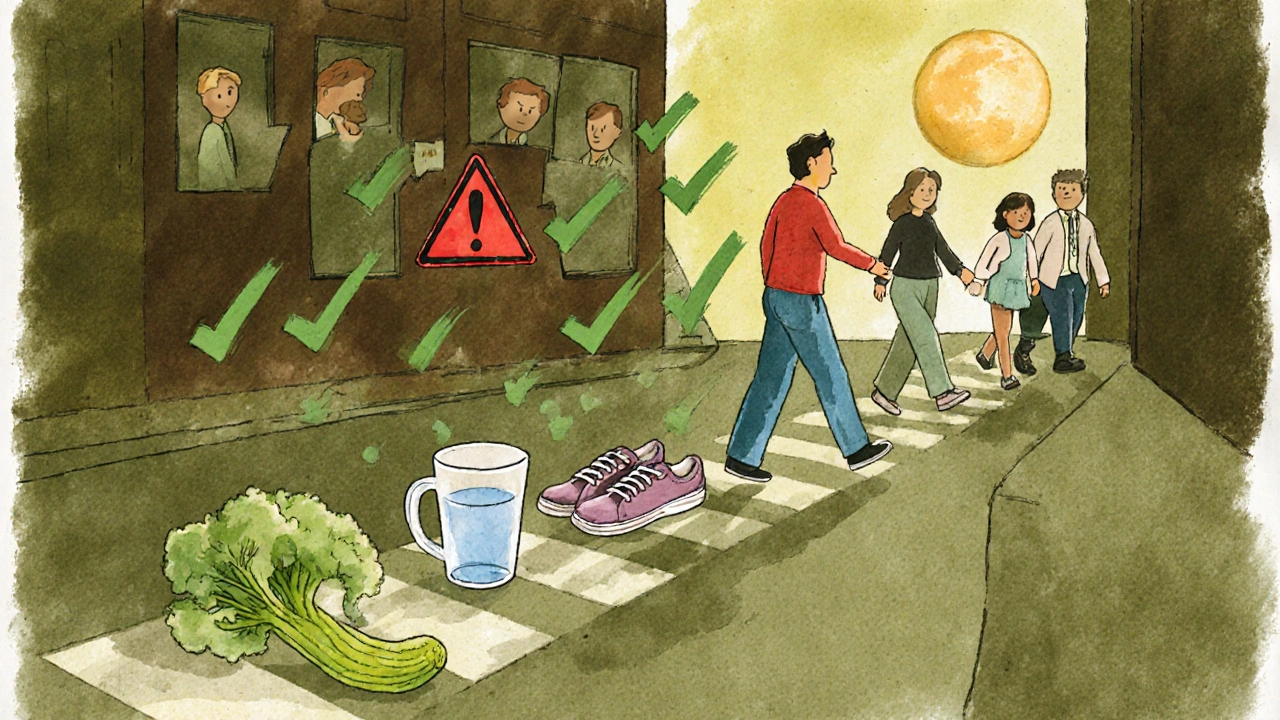More than one in three adults in the U.S. has metabolic syndrome - and most don’t even know it. It’s not a single disease. It’s a cluster of warning signs that quietly stack up, turning your body into a ticking time bomb for heart disease, stroke, and type 2 diabetes. If you’ve been told you have high blood pressure, high triglycerides, or extra belly fat, and no one connected the dots, you’re not alone. This isn’t just about numbers on a lab report. It’s about what those numbers mean together - and what you can actually do about it.
What Exactly Is Metabolic Syndrome?
Metabolic syndrome isn’t a diagnosis you get from one test. It’s when at least three of five specific health markers go off the charts at the same time. These aren’t random issues. They’re linked by one core problem: insulin resistance. That’s when your muscle, fat, and liver cells stop responding properly to insulin, the hormone that moves sugar from your blood into your cells. Your pancreas responds by pumping out more insulin, which eventually wears it down. That’s how you end up with high blood sugar, fatty liver, and abnormal cholesterol - all at once.
The official criteria, set by the American Heart Association and the National Heart, Lung, and Blood Institute, are clear:
- Waist size over 40 inches for men, 35 inches for women (lower for Asian populations)
- Triglycerides at or above 150 mg/dL
- HDL (good) cholesterol below 40 mg/dL for men, 50 mg/dL for women
- Blood pressure at or above 130/85 mmHg
- Fasting blood sugar at or above 100 mg/dL
Having just one of these doesn’t mean much. But three or more? That doubles your risk of heart disease and makes type 2 diabetes five times more likely. The problem? Most doctors treat each number separately. High blood pressure? Prescribe a pill. High cholesterol? Add a statin. But if you don’t fix the root cause - insulin resistance - you’re just playing whack-a-mole with your health.
Why Belly Fat Is the Real Culprit
Not all fat is the same. Subcutaneous fat - the kind you can pinch on your thighs or arms - is mostly harmless. Visceral fat, the kind that wraps around your liver and intestines, is the dangerous kind. That’s what waist measurement measures. And it’s not just a passive storage unit. Visceral fat is metabolically active. It releases fatty acids directly into your liver, triggers inflammation, and messes with your hormones. That’s why two people with the same BMI can have wildly different risks - one has a lean waist, the other carries weight around the middle.
Studies show that for every extra inch of waist size beyond the threshold, your risk of heart disease climbs. In the Framingham Heart Study, people with abdominal obesity and high blood sugar had a 2.5 times higher risk of heart attack than those with neither. And here’s the kicker: you can have a normal weight and still have visceral fat - a condition called TOFI (thin outside, fat inside). It’s common in people with a family history of diabetes or who’ve lost weight and regained it.
The Silent Progression: From Insulin Resistance to Heart Attack
Metabolic syndrome doesn’t show up overnight. It builds slowly over years. It starts with your body becoming less sensitive to insulin after years of eating too many refined carbs and sitting too much. Your pancreas compensates. Your blood sugar creeps up. Your liver starts making more triglycerides. HDL drops. Blood pressure rises. Your arteries begin to stiffen. Inflammation spreads. You might feel fine - no chest pain, no dizziness. But inside, your blood vessels are slowly getting damaged.
By the time someone gets diagnosed with type 2 diabetes, the damage to their heart is often already underway. That’s why metabolic syndrome is such a critical red flag. It’s the last chance to reverse things before irreversible damage sets in. The Diabetes Prevention Program showed that losing just 7% of your body weight and walking 150 minutes a week cut the risk of developing diabetes by 58%. That same intervention also reversed metabolic syndrome in 41% of participants over 10 years.

Why Medications Alone Don’t Fix It
There’s no pill approved specifically to treat metabolic syndrome. That’s not an accident. The drugs we have - statins, blood pressure meds, metformin - treat individual pieces. They help, but they don’t fix the underlying problem. And they come with side effects. Statins can cause muscle pain. Blood pressure meds can make you dizzy. Metformin can cause stomach upset. None of them make you feel better in the long run unless you change your lifestyle.
People who rely only on medication often end up on more pills over time. One study tracked patients with metabolic syndrome for five years. Those who didn’t change their diet or activity level ended up taking an average of 3.8 medications by year five. Those who lost weight and moved more cut that number in half - and many stopped all meds entirely.
The real solution? Lifestyle isn’t a backup plan. It’s the frontline treatment. The Mayo Clinic’s Integrated Metabolic Syndrome Program found that 68% of participants reversed the syndrome after 12 months of structured diet, exercise, and coaching. That’s not magic. That’s science.
What Actually Works: The Proven Plan
If you’ve been told you have metabolic syndrome, here’s what you need to do - and how to do it right:
- Focus on waist size, not just weight. Aim to lose 7% of your body weight. For someone who weighs 200 pounds, that’s 14 pounds. That’s enough to improve insulin sensitivity and lower blood pressure.
- Move daily - not just at the gym. 150 minutes of moderate activity per week is the minimum. That’s 30 minutes, five days a week. Brisk walking counts. Gardening counts. Dancing counts. Don’t wait for perfect conditions. Just start.
- Change what’s on your plate. Cut out sugary drinks, white bread, pastries, and processed snacks. Focus on vegetables, lean protein, whole grains, nuts, and healthy fats like olive oil and avocado. You don’t need to count calories if you cut out the junk. Most people naturally eat fewer calories when they eat real food.
- Get sleep and manage stress. Poor sleep and chronic stress raise cortisol, which increases belly fat and insulin resistance. Aim for 7-8 hours a night. Try walking after dinner, meditating for 10 minutes, or journaling before bed.
- Get support. Trying to do this alone is why most people fail. Join a structured program like the National Diabetes Prevention Program. Use apps like DarioHealth’s Metabolic+ that track glucose and give daily coaching. Talk to a dietitian. Find a workout buddy.
People who stick with this for six months typically see their triglycerides drop by 30%, HDL rise by 10%, blood pressure fall by 10 points, and fasting sugar normalize. Waist size shrinks by 2-4 inches. That’s not just numbers. That’s your body healing.

The Real Barrier: Healthcare That Doesn’t Connect the Dots
Here’s the frustrating part: most people with metabolic syndrome aren’t even told they have it. A survey of 1,247 patients found that 68% were never diagnosed as having the syndrome - even though they had three or more risk factors. Doctors see high blood pressure and treat it. They see high cholesterol and treat it. But they rarely say: “You have metabolic syndrome. Here’s how to reverse it.”
And even when they do, care is fragmented. You see your cardiologist for blood pressure, your endocrinologist for blood sugar, your primary care doctor for cholesterol. No one coordinates. No one says: “Let’s fix this together.”
Patients who got care from a team - dietitian, exercise physiologist, behavioral coach - had three times the success rate of those who saw doctors one at a time. The CDC’s National Diabetes Prevention Program, run by community health workers, showed better results in Hispanic and Black communities than traditional clinic-based care. Why? Because they met people where they were. They didn’t just hand out pamphlets. They showed up.
Hope Is Real - And It’s Within Reach
The Diabetes Remission Clinical Trial (DiRECT) gave people with type 2 diabetes and metabolic syndrome a very low-calorie diet (825-850 calories/day) for 3-5 months, followed by gradual food reintroduction and long-term support. After one year, 46% of participants reversed their diabetes. Their blood sugar normalized. Their insulin sensitivity improved. Their waist size dropped by an average of 15 cm. Many stopped all medications.
That’s not a miracle. That’s physiology. When you remove the excess fat from your liver and pancreas, those organs start working again. The body has an incredible ability to heal - if you give it the right conditions.
Metabolic syndrome isn’t your destiny. It’s a signal. A loud, clear signal that your lifestyle needs to change. And the good news? You don’t need to be perfect. You don’t need to run a marathon. You just need to start. One walk. One less sugary drink. One more vegetable at dinner. Those small steps add up. And they can change your future.
Can you have metabolic syndrome and still be thin?
Yes. Some people carry excess fat around their organs even if they look lean on the outside. This is called TOFI - thin outside, fat inside. It’s common in people with a family history of diabetes, those who’ve lost and regained weight, or those who’ve been sedentary for years. Waist measurement is a better indicator than BMI.
Is metabolic syndrome reversible?
Absolutely. Studies show that losing just 5-7% of body weight through diet and exercise can reverse metabolic syndrome in up to 40% of people within six months. The Diabetes Prevention Program and DiRECT trial both proved that lifestyle changes can normalize all five risk factors without medication.
Do I need medication for metabolic syndrome?
Not necessarily. Medications can help manage individual risk factors like high blood pressure or cholesterol, but they don’t fix the root cause - insulin resistance. Lifestyle changes are the only proven way to reverse the syndrome. Many people who stick with diet and exercise eventually stop all medications.
What foods should I avoid with metabolic syndrome?
Avoid sugary drinks (soda, juice, sweetened coffee), refined carbs (white bread, pasta, pastries), processed snacks (chips, cookies), and fried foods. These spike blood sugar and insulin, worsening insulin resistance. Focus on whole foods: vegetables, lean proteins, nuts, seeds, legumes, and healthy fats like olive oil and avocado.
How long does it take to reverse metabolic syndrome?
Most people see improvements in blood pressure, triglycerides, and blood sugar within 3-6 months of starting lifestyle changes. Waist size often drops noticeably in the first 2-3 months. Full reversal - meaning no more three of the five criteria - typically takes 6-12 months with consistent effort. The key is sustainability, not speed.




Jefriady Dahri, November 25, 2025
man i used to think i was fine 'cause i wasn't fat but then i found out my waist was 38 inches and my triglycerides were through the roof. no symptoms, no pain, just silently dying inside. started walking after dinner and cutting soda. 6 months later, my doc was like 'wait, did you lose weight?' i hadn't even stepped on a scale. this stuff works if you just start.